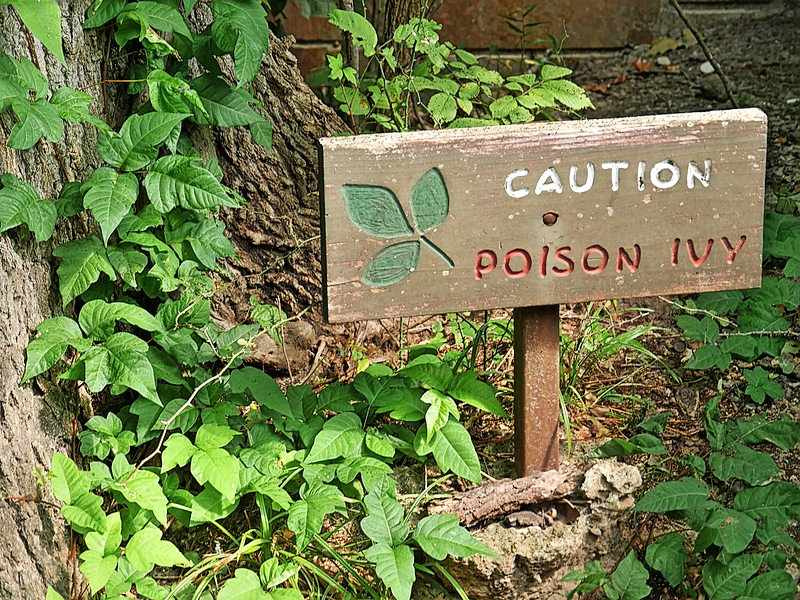Please Don’t Eat the Daisies
By Naperville Magazine
Appears in the July 2023 issue.
By Kelli Ra Anderson
Toxic plants to avoid in your own backyard

When Ed Kotynski removed poison ivy around his shed, he thought he took plenty of precautions. “I wore gloves and covered my neck and arms,” he recalls. “But as I tore out the roots embedded in the walls of the shed, it created a lot of dust. At the time I didn’t know there was more poison in the roots than the leaves—and that is what I was inhaling.” Kotynski ended up with systemic poisoning that left him miserable for months while he recovered on prescription steroids.
While we tend to think of our yards and gardens as oases, it’s not all, well, a bed of roses. Other botanical villains possibly lurking include poison oak (similar to poison ivy); water hemlock (very deadly even to touch) with white or green frilly, umbrella-like blossoms; and wild parsnip (its sap causes burns when activated by sunlight) with lacy yellow blooms.

The good news, however, is that not all noxious plants are outright deadly. “A lot are toxic,” explains Jamie Viebach, horticultural educator at the Illinois University Extension in Naperville. “But (a) they won’t taste good, so most of us won’t eat much of them, and (b) the worst many will give you is an upset stomach—barring allergic reactions because people do have allergies.” Of course, children and pets need supervision, so pay close attention to what’s growing on and near your property.
Some unwelcome invaders are downright dicey, like giant hogweed, a hard-to-miss 15- to 20-foot-tall plant that causes painful chemical burns if touched, landing it on many Illinois naturalists’ “most dangerous” lists.

Some toxic plants, however, actually have been invited. “In the past 10 years, more people like to put tropicals on their patios for a pop of color, like oleander and angel’s trumpet,” says Liz Holmberg, newly retired greenhouse owner and manager of Lizzie’s Garden for the past 32 years. “All parts of oleander are toxic, so you don’t want to roast your marshmallows on it.” Other common decorative plants she cautions against are philodendrons, caster beans, yews, and foxgloves, whose stems, leaves, flowers, and resulting pods are all harmful in varying degrees.

Watch out for the Jekyll-and-Hyde plants, which can be both perfectly edible or terribly toxic. Cow parsnip (often confused with giant hogweed) is six feet tall and can cause burns, but its leaves and seeds are edible when harvested and prepared properly. Elderberries also warrant caution—while ripe berries are used as immunity-boosters, there are low levels of cyanide in the shrub’s leaves, stems, and unripe fruit. Likewise, rhubarb stalks may make for an excellent pie filling, but its leaves are poisonous to humans and animals. Pokeweed, which pops up with its long clusters of deep-purple berries, is toxic. But Native Americans, early pioneers, and Southern foodies enjoy its spring leaves, rendered safe after thorough boiling. So, it depends.
All in all, though, it’s best to always play it safe. “Look, here’s some general, common-sense advice: If you are planting for decoration–don’t eat those plants,” Holmberg says.” Don’t eat your hydrangea. Don’t eat the daisies.”
Fighting Poison Ivy
No part of poison ivy is safe to touch—all of this native-but-nasty plant contains a toxic, oily resin called urushiol. When removing the plant, always wear a mask and eye protection as well as rubber gloves, long sleeves, long pants, and work boots.
Cut all the stems to the ground and seal them in a plastic bag. Be careful not to tear or rip the vines so as not to release urushiol into the air. Next, dig out the roots and bag these for disposal as well (don’t compost any part of the plant). Never burn poison ivy because the smoke can be toxic, irritating your eyes and lungs.
Afterward, clean your tools with vinegar and turn your clothes inside out and wash them separately from other laundry. Just throw the gloves away, and wash your hands thoroughly with soap and water.
Photos: University of Illinois Extension (water hemlock and pokeweed); iStock


